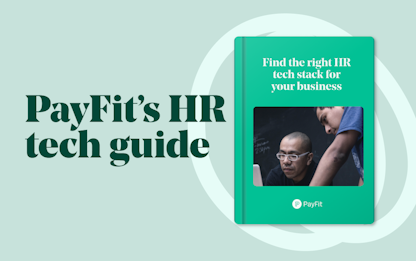- Blog
- |People management
- >Employee wellbeing
- >Different types of flexible working explained
Types of Flexible Working: A Definitive Guide for HR Leaders


Flexibility in the UK workplace is an incredibly broad topic. Open up this umbrella term, and you’ll find there are many different types of flexible working arrangements to talk about.
Indeed, the landscape is evolving quickly, and every employee has different needs and preferences. With so many different practices and arrangements UK businesses can offer, it can be challenging to understand all the different kinds of flexible working practices you can make available to your employees.
Let’s take a step back and examine all the different flexible working hours examples there are, along with some practical examples and advice for implementing these strategies within your company.
But first, what is flexible time?
We’ve touched on what flexible working is before on our blog where we’ve defined flexible hours as a concept, but to sum this up, it refers to any way of working that differs from the 9-5 norm. In other words, it’s a variation on the traditional work schedule or location. Your employees get to adjust their work patterns to better suit their personal lives and in return you get a healthier, happier more engaged workforce.
It's a practice that UK law now supports as a day-one right and is part of a larger commitment to foster healthier, more equitable work environments across the nation.
What are the different types of flexible working arrangements?
As we mentioned before, the UK ‘flexi-workingverse’ is a diverse landscape, and that makes it an exciting new frontier for HR leaders. Of course, it’s impossible to cater to every single kind of requested working pattern. Still, the more different types of arrangements you cater for with your flexible working policy, the more attractive and competitive you will be as an employer.
Here are some of the most common examples of flexibility in work which you may (or may not!) have heard of.
Flexitime: The freedom to choose
Perhaps the most popular form of flexible working, flexitime gives employees the freedom to fit their core working hours in and around their individual needs and commitments. Allowing employees to choose their start and finish times is one way of achieving this, but it’s not the only way.
Within this arrangement, you can include 'core hours' — a period during the day when you ask all employees to be present in addition to providing flexibility outside these times.
This arrangement allows employees to tailor their working schedule so it better suits their needs and can be practised in tandem with other types of flexible working such as work-from-home (WFH). Some of your people may choose this to avoid the stress of commuting or to fit in childcare responsibilities or to carve out more time when they’re ‘off duty’ for hobbies and personal interests.
Compressed Hours: full-time hours, fewer days
Compressed hours, or condensed hours, are just that - work hours squeezed into fewer days. Instead of reducing their hours to part-time or opting for a job share, employees can work more hours over fewer days so they can enjoy a longer break on other days of the week.
A typical example is the four-day work week, where an employee might work four 10-hour days to enjoy a three-day weekend. This arrangement can significantly enhance work-life balance and reduce commuting times.
Compressed hours can be particularly useful if an employee has another project outside of work such as a side hustle, small business or in the case of them pursuing a course or degree.
PayFit Top Tip:
As a UK employer, you can facilitate this type of arrangement by scheduling in different employees to be ‘on duty’ on different days of the week. That way you ensure your core business hours are still covered but by different employees on different days.
Part-Time: working fewer hours
Most of us will be familiar with this particular type of flexible work. Part-time working arrangements have been around for a while now, and it’s highly likely that you already have employees at your organisation on such contracts. When workers complete less than the standard full-time hours, their pay and benefits are adjusted accordingly.
Many employees may choose this way of working in order to spend more time with their family or if they’re studying at college or University. It’s not uncommon, for instance, for one or both parents to switch to a part-time contract. When you’re a busy family, keeping living spaces tidy, cooking healthy meals and spending quality time with children becomes more challenging. Childcare costs can also be high, so a part-time working arrangement might allow families to spend less money.
Annualised hours: a seasonal approach
Similar in approach to flexitime, annualised hours involve calculating the employees' working hours on an annual rather than weekly or monthly basis. This particular approach can be highly applicable to more seasonal work, where there are periods of high and low work intensity.
Staggered Hours: different start and finish times
Staggered hours lets employees decide on their start, finish, and break times. This flexible working practice allows employees to fit work in and around other life commitments and can be particularly useful for parents who need to drop off and pick up their kids from school or childcare.
From a business perspective, staggered hours can also be incredibly useful as they can help extend operating hours so you get more coverage throughout the day and week.
Remote working or work from home: location independence
Out of all the different examples of flexibility in work, remote working or working from home (WFH) has garnered the most media attention. It’s what kept many businesses afloat during the pandemic, which resulted in significant shifts in employment practices.
Remote working encompasses everything from working from home to co-working spaces or any other location. For many employees, the benefits of working from home far outweigh the costs. Workers enjoy more flexibility while spending less time, energy and pounds on commuting.
PayFit Top Tip:
It’s important to note that not everyone will be well suited to WFH arrangements and while there are many benefits, it comes with a host of disadvantages too. Employees can find it challenging to keep on top of deadlines and may find they’re lonelier and miss the ‘buzz’ of the office. All that said, there are countless ways to adjust home working to mitigate a lot of these disadvantages.
Job Sharing: shared responsibilities
One creative solution to providing more flexibility is job sharing. This is where two (or more) people share the responsibilities of a full-time position. Each person works part of the week or alternate weeks, offering a balance between professional and personal life.
With this setup, employees are encouraged to share overall accountability and success for the role. These positions can be a little more challenging than the norm and involve more strategic responsibility. Given this, they are well suited to employees who are more autonomous but who want more flexibility in their schedules.
Zero-hours contracts: work on demand
Under zero-hours contracts, employees are not guaranteed a set number of hours. They work as and when required, which can offer flexibility for those balancing multiple commitments or seeking varied work experiences. However, the lack of guaranteed work can also be a downside for some.
Flexibility in work: more than just a trend
Flexible working isn’t just a trend; it's an evolution in how we approach work and productivity.
By understanding and leveraging the various types of flexible working arrangements, UK businesses can create a more adaptable, satisfied, and efficient workforce. Success lies in clear communication, flexibility, and the right tools to manage these arrangements. Armed with the insights from this guide, you're well on your way to fostering a dynamic work environment that caters to the diverse needs of your team.


HR In The Boardroom - The Business Benefits Of Strategic HR

PayFit Launches New Open API for Improved Integations

The Benefits Of Flexible Working For the UK Worforce

Leave & Absence Management Made Easier

Types Of Flexible Working - A Guide For Employers


